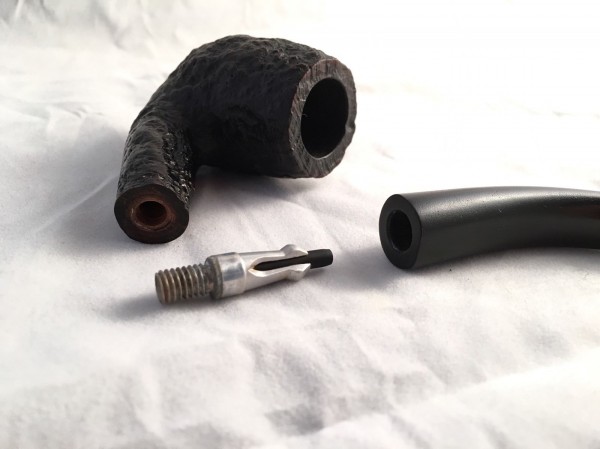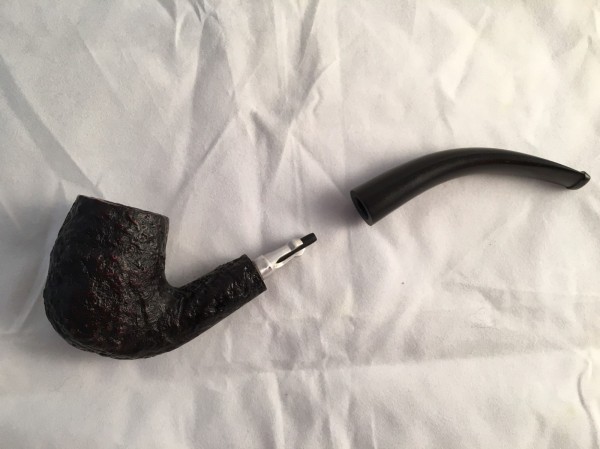Folks who actually know what they're talking about will surely chime in :D , but for some reason I thought the Vernon tenon came in two forms -- one that snapped into the shank, and one that snapped into the stem itself (the one in the OP being an example of the latter).I have a question, shouldn't the fixed part of the Vernon fitment be in the stem, with the sprung prongs fitting into the shank, as seen on johnnyreb's stem? It also appears that way in the example at pipedia,
Rare Vernon Dunhill (1935) re-stem
- Thread starter georged
- Start date
You are using an out of date browser. It may not display this or other websites correctly.
You should upgrade or use an alternative browser.
You should upgrade or use an alternative browser.
SmokingPipes.com Updates
Watch for Updates Twice a Week
- Status
- Not open for further replies.
You aren't imagining things.Folks who actually know what they're talking about will surely chime in :D , but for some reason I thought the Vernon tenon came in two forms -- one that snapped into the shank, and one that snapped into the stem itself (the one in the OP being an example of the latter).
Here in another example of the rarer "spring attached to the shank" variety:
http://www.ebay.com/itm/ENGLISH-ESTATE-PIPE-DUNHILL-DR-R-ROOT-w-VERNON-TENON-PATENT-1935-/361884478833?hash=item5441feed71
The detent ring is what the spring fingers expand into, but I think that's what you meant.So, there is a "detente" inside the stem that compresses the prongs?
My guess is the other first design didn't stay tight with use because the wood is softer than vulcanite and compressed / became worn, so the mechanism was reversed for version 2.0.
Both were an ingenious solution to a non-existent problem as well as being difficult to clean (and when gunky neither worked very well), so never found many fans, though.
Semantics here, but the springs are compressed the entire time the stem is on the pipe. They're compressed more (for a short time) as it's being put on or taken off, though.Just so I understand...as the fitment goes into the stem's airway, what is compressing the springs?
The "what" is the stem itself, of course. It's the varying diameter of the hole down its length that controls (for lack of a better word) the amount of spring compression.
Tricky little bastards to make for a number of technical reasons, not the least of which is that the stem won't work right if some of the interior dimensions are off by even a couple thousandths of an inch.
This is really just driving me a little crazy. George, the stem is somehow drilled becoming narrower in diameter, before becoming slightly less narrow further down the airway allowing the springs to expand?
About the Patents, the pipe in the OP has the 1932 US Patent referenced in my reply above, where the fitment is clearly threaded into the stem, with the spring fitting going into the shank.
http://www.folloder.com/pdf/1861910.pdf
A couple of other things, the Patent on the ebay 1935 Dunhill pipe, PAT. Nº 358812, doesn't appear to have anything to do with the Vernon fitting,
https://worldwide.espacenet.com/publicationDetails/biblio?FT=D&date=19311015&DB=EPODOC&locale=en_EP&CC=GB&NR=358812A&KC=A&ND=4#
However, another Dunhill Patent 363582 from 1931, does show the fitment, with the same arrangement as shown in the US Patent docs/drawings.
https://worldwide.espacenet.com/publicationDetails/biblio?DB=EPODOC&II=112&ND=3&adjacent=true&locale=en_EP&FT=D&date=19311224&CC=GB&NR=363582A&KC=A#
Either something isn't right here, or I just can't find a patent with the reversed fitting. Of course ther is this, but without any abstract...
https://worldwide.espacenet.com/publicationDetails/biblio?DB=EPODOC&II=115&ND=3&adjacent=true&locale=en_EP&FT=D&date=19320816&CC=CA&NR=325090A&KC=A#
About the Patents, the pipe in the OP has the 1932 US Patent referenced in my reply above, where the fitment is clearly threaded into the stem, with the spring fitting going into the shank.
http://www.folloder.com/pdf/1861910.pdf
A couple of other things, the Patent on the ebay 1935 Dunhill pipe, PAT. Nº 358812, doesn't appear to have anything to do with the Vernon fitting,
https://worldwide.espacenet.com/publicationDetails/biblio?FT=D&date=19311015&DB=EPODOC&locale=en_EP&CC=GB&NR=358812A&KC=A&ND=4#
However, another Dunhill Patent 363582 from 1931, does show the fitment, with the same arrangement as shown in the US Patent docs/drawings.
https://worldwide.espacenet.com/publicationDetails/biblio?DB=EPODOC&II=112&ND=3&adjacent=true&locale=en_EP&FT=D&date=19311224&CC=GB&NR=363582A&KC=A#
Either something isn't right here, or I just can't find a patent with the reversed fitting. Of course ther is this, but without any abstract...
https://worldwide.espacenet.com/publicationDetails/biblio?DB=EPODOC&II=115&ND=3&adjacent=true&locale=en_EP&FT=D&date=19320816&CC=CA&NR=325090A&KC=A#
That's the easiest way to think of it, yes.This is really just driving me a little crazy. George, the stem is somehow drilled becoming narrower in diameter, before becoming slightly less narrow further down the airway allowing the springs to expand?
As for patent numbers and related, I haven't a clue. I just work on 'em. :lol:
George, it seems your speculation on our phone call was correct. As I said, I asked my go to Dunhill collector in Denmark about it with a link to this thread, his email reply,
Dave,
that Vernon fit is correct... it was changed from sitting in the mouthpiece to being installed in the tenon hole.
The full English Patent for the record that a friend found for me. It does seem that Dunhill, or the people who actually had to make this setup, decided to change the arrangement at some point.
https://worldwide.espacenet.com/publicationDetails/originalDocument?CC=GB&NR=363582A&KC=A&FT=D&ND=3&date=19311224&DB=EPODOC&locale=en_EP#
https://worldwide.espacenet.com/publicationDetails/originalDocument?CC=GB&NR=363582A&KC=A&FT=D&ND=3&date=19311224&DB=EPODOC&locale=en_EP#
- Status
- Not open for further replies.










